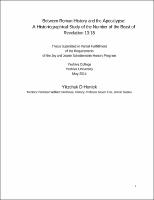Please use this identifier to cite or link to this item:
https://hdl.handle.net/20.500.12202/4251Full metadata record
| DC Field | Value | Language |
|---|---|---|
| dc.contributor.author | Honick, Yitzchak D. | |
| dc.date.accessioned | 2018-11-14T20:46:46Z | |
| dc.date.available | 2018-11-14T20:46:46Z | |
| dc.date.issued | 2014-05 | |
| dc.identifier.uri | https://hdl.handle.net/20.500.12202/4251 | |
| dc.identifier.uri | https://ezproxy.yu.edu/login?url=https://repository.yu.edu/handle/20.500.12202/4251 | |
| dc.description | The file is restricted for YU community access only. | |
| dc.description.abstract | Perhaps no part of the New Testament has been as completely assimilated into contemporary imagination as the number 666. The Number has been used to varied effect in religion, politics, and media. However, the imagined Beast is often fantasized and removed from the original verse. The Jewish Annotated New Testament uses the New Revised Standard Version of the New Testament, which reads, “This calls for wisdom: let anyone with understanding calculate the number of the beast, for it is the number of a person. Its number is six hundred sixty-six.”1 The commentary on this verse, written by David Frankfurter, shows that when spelled with Hebrew letters, the Greek rendering of Nero’s name gives the number 666. Frankfurter specifically defines this interpretation as an example of gematria, or Jewish numerology.2 While Frankfurter is certainly correct that this is an example of gematria, such numerology is also found in Rome and Greece, where it is known is Isopsephy, and there is little that suggests that this must be read as gematria. This has not stopped the Nero interpretation from becoming the dominant option accepted by most scholars. Remarkably, though, the first suggestion of Nero as the Beast only dates to 1831. Despite the popular acceptance of this theory, however, there is little discussion regarding what interpretations predate Nero and why there was such a dramatic shift in interpretation. | en_US |
| dc.description.sponsorship | Jay and Jeanie Schottenstein Honors Program | en_US |
| dc.language.iso | en_US | en_US |
| dc.publisher | Yeshiva College | en_US |
| dc.rights | Attribution-NonCommercial-NoDerivs 3.0 United States | * |
| dc.rights.uri | http://creativecommons.org/licenses/by-nc-nd/3.0/us/ | * |
| dc.subject | Nero, Emperor of Rome, 37-68. | en_US |
| dc.subject | Beast of the Apocalypse. | en_US |
| dc.subject | Six hundred and sixty-six (The number) in the Bible. | en_US |
| dc.subject | New Testament. Revelation XIII,18 --Criticism, interpretation, etc. | en_US |
| dc.title | Between Roman History and the Apocalypse: A Historiographical Study of the Number of the Beast of Revelation 13:18 | en_US |
| dc.type | Thesis | en_US |
| Appears in Collections: | Jay and Jeanie Schottenstein Honors Student Theses | |
Files in This Item:
| File | Description | Size | Format | |
|---|---|---|---|---|
| Yitzchak-D-Honick.pdf Restricted Access | 1.15 MB | Adobe PDF |  View/Open |
This item is licensed under a Creative Commons License

